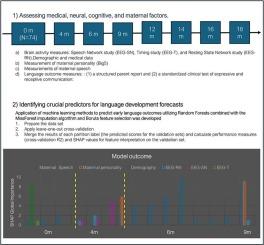从神经连接和母亲言语预测婴儿词汇:一种机器学习方法。
IF 2.6
4区 医学
Q3 NEUROSCIENCES
引用次数: 0
摘要
识别语言发展的早期预测因素对于理解婴儿在生命的最初几年是如何获得词汇的至关重要。虽然之前的研究已经确定了婴儿指向性言语(IDS)和神经语音处理的重要性,但这项纵向研究引入了一种新的方法,将基于脑电图的功能连接分析和机器学习相结合,以评估母婴神经因素对语言结果的共同贡献。在出生和9个月时收集数据,包括母亲的性格和语言特征,以及婴儿在语言处理过程中的脑电图反应。在18 个月时使用标准化方法评估语言理解和表达能力。研究人员使用机器学习框架对这些变量的预测贡献进行建模,结果表明,母亲的语音韵律和脑电图网络特性是日后词汇量的最强预测因素之一。这些发现突出了使用数据驱动方法整合神经和环境数据的价值,并为未来的早期语言习得研究提供了有针对性的方向。本文章由计算机程序翻译,如有差异,请以英文原文为准。

Predicting infant vocabulary from neural connectivity and maternal speech: A machine learning approach
Identifying early predictors of language development is essential for understanding how infants acquire vocabulary during the first years of life. While previous studies have established the importance of infant-directed speech (IDS) and neural speech processing, this longitudinal study introduces a novel approach by combining EEG-based functional connectivity analysis and machine learning to assess the joint contribution of maternal and infant neural factors to language outcomes. Data were collected at birth and nine months, including maternal personality and speech characteristics, alongside infant EEG responses during speech processing. Language comprehension and production were assessed at 18 months using a standardized measure. A machine learning framework was used to model the predictive contribution of these variables, revealing that maternal speech prosody and EEG network properties were among the strongest predictors of later vocabulary. These findings highlight the value of integrating neural and environmental data using data-driven approaches and suggest targeted directions for future research on early language acquisition.
求助全文
通过发布文献求助,成功后即可免费获取论文全文。
去求助
来源期刊

Brain Research
医学-神经科学
CiteScore
5.90
自引率
3.40%
发文量
268
审稿时长
47 days
期刊介绍:
An international multidisciplinary journal devoted to fundamental research in the brain sciences.
Brain Research publishes papers reporting interdisciplinary investigations of nervous system structure and function that are of general interest to the international community of neuroscientists. As is evident from the journals name, its scope is broad, ranging from cellular and molecular studies through systems neuroscience, cognition and disease. Invited reviews are also published; suggestions for and inquiries about potential reviews are welcomed.
With the appearance of the final issue of the 2011 subscription, Vol. 67/1-2 (24 June 2011), Brain Research Reviews has ceased publication as a distinct journal separate from Brain Research. Review articles accepted for Brain Research are now published in that journal.
 求助内容:
求助内容: 应助结果提醒方式:
应助结果提醒方式:


